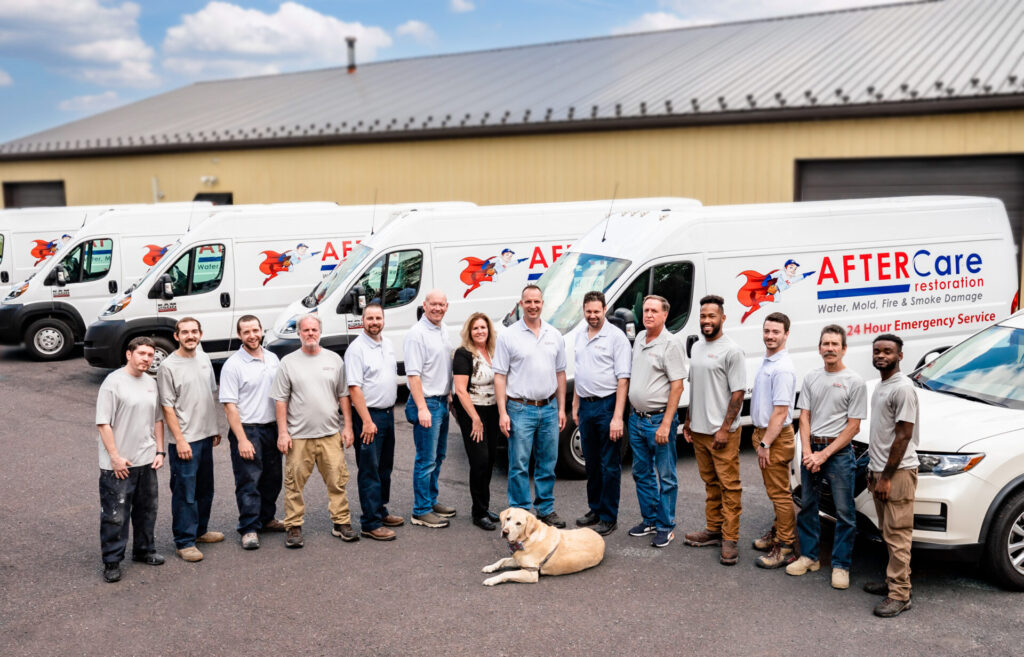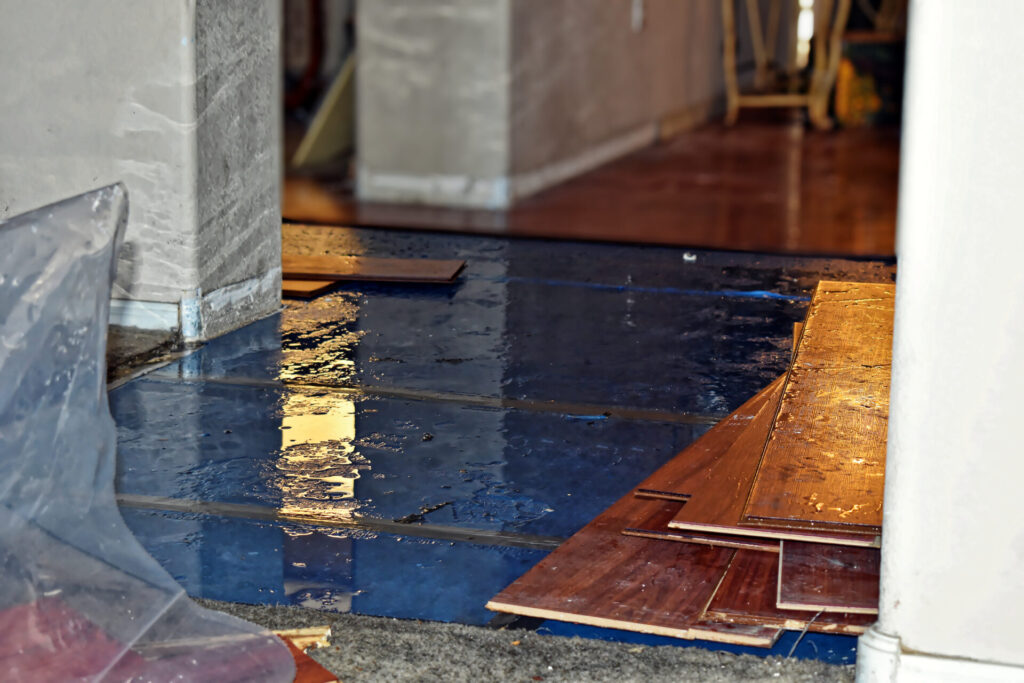
Call 24/7 AfterCare Restoration 215.515.1000
If you’ve experienced a flood or other significant water damage to your home, you’re probably eager to start the restoration process. Before that can begin, however, there’s another important step that must be taken to prepare your home for restoration work: water mitigation.
At its essence, water mitigation is the process of removing the water from your home, assessing the damage, and taking whatever temporary measures are necessary to secure your home’s integrity, such as tarping damaged roofs and boarding up broken windows. It may sound simple, but there’s actually quite a bit that goes into this all-important preparatory step.
Note: Some of the steps in water mitigation can be undertaken by the homeowner. However, if the flooding involves sewage or water from a nearby body of water entering your home, be aware that the water may be contaminated with waste, pathogens, or other dangerous pollutants. If this is the case, you must take extreme care and wear protective equipment when dealing with flood waters. Or, leave the work to a professional water damage restoration team.
Step 1: Remove Any Remaining Water
The first step taken in a water mitigation project is making sure that the water has been removed from the home. If the flood came from a plumbing issue such as a broken pipe or clogged drain, this step also includes repairing the damaged plumbing to prevent any future water damage.
If the flooding was significant, mitigation may involve using industrial wet/dry vacuums, submersible sump pumps, or other means to rid the house of excess water. For smaller flooding events, water removal may simply involve sweeping away standing puddles and allowing airflow to dry up the remaining water.
Step 2: Remove Damaged Materials
After a flood, your home’s drywall and flooring are likely damaged to a certain extent. Wood flooring, laminate, and carpets are particularly susceptible to water damage; drywall that’s been submerged is also typically unrecoverable.
During the mitigation process, damaged flooring and drywall are removed. This not only removes the water-soaked materials from your home (along with the mold and mildew risk that they pose), but also exposes your home’s subflooring and wall structure for inspection.
Step 3: Inspect for Structural Damage & Dry Out
When it enters your home, water finds every available space to fill, including inside your walls and other unseen areas. Allowing structural elements such as wall framing, subfloor decking, or floor structure to remain wet following a flood is asking for future problems.
Wet structural elements are a breeding ground for mildew and dangerous mold strains. Termites are attracted to water, so leaving wet wood in your walls or floors can invite the destructive insects to take up residence. Last but certainly not least, water-damaged wood is likely to start rotting prematurely, leaving your home’s structure weakened and unsafe.
With drywall and flooring removed, fans and dehumidifiers can be brought in and set to work drying out subfloors and structural members.
Step 4: Make Temporary Repairs
Now isn’t the time to start reinstalling drywall and repainting. Before permanent restoration work is done, your home must first be secured and its structural integrity restored for long enough to allow more lengthy restoration work to proceed:
- Any damaged structural members must be shored up or scabbed to maintain the home’s structural integrity.
- Roof damage should be covered with tarps to prevent rain or other precipitation from causing a second flood.
- Any broken windows or door should be boarded up with plywood or exterior-grade OSB panels.
- Any other damage that compromises the home’s water protection, security, or structure must be addressed as safely and quickly as possible.
Step 5: Clean and Disinfect
If any of your personal items or any of your home’s furnishings are recoverable, now is the time to begin cleaning and disinfecting them. If you have water-damaged personal items, you can follow these steps to start recovering them from their damaged state.
Depending on the level of damage, furnishings may be recoverable. Any fabrics that can be machine washed should be, using the recommended settings for that material. If possible, remove the covers from any cushions or pillows – tumble dry smaller cushions, and line-dry any cushions that won’t fit in a dryer. (Pro tip: Many laundromats have high-capacity dryers that can handle much larger items than most residential machines).
Wooden furniture with minor damage can usually be cleaned using regular household cleaners or with a solution of water and trisodium phosphate (TSP, available at most hardware or home improvement stores). If wooden furniture has warped, cracked, or swollen, its repair will be more complicated. If you’re not a skilled woodworker, your water damage restoration team or a local cabinetry shop may be able to help.
The water-damaged materials in your home will also need to be cleaned. Use household ammonia or TSP to clean floors and walls. If mud, grease, or other contaminants have built up on the surfaces, liquid cleaners like Ajax and Mr. Clean are good at helping to break up the dirt so it can be washed away.
Once everything is cleaned, use a powerful disinfectant such as Lysol or a bleach solution to ensure that all traces of mold, mildew, bacteria, or other pathogens are destroyed.
Step 6: Begin Restoration Work
Once the following statements are all true, the work of mitigation is over and the restoration process can begin:
- All water-damaged drywall and flooring have been removed from the home.
- All furnishings and personal items that are damaged beyond recovery are removed from the home.
- The home’s structure has been inspected for damage and any damaged elements have been shored up temporarily.
- The home has been thoroughly dried out and all structural elements are dry and clean.
- All remaining furnishings and personal items have been cleaned and disinfected.
- All of the structure and surfaces remaining in the home have been cleaned and disinfected.

After a Flood, Contact AfterCare Restoration Right Away to Begin Mitigation and Restoration for Your Home:
Call 24/7 AfterCare Restoration 215.515.1000
Related Articles:
- Can I Get Federal Assistance for Water Damage Restoration After a Flood?
- How to Recover Personal Items After Water Damage
AfterCare Restoration is a Local Family- & Veteran-Owned damage restoration company. We specialize in 24/7 water damage restoration, fire board-up, fire damage restoration, smoke damage restoration, and full reconstruction services.
At AfterCare, we use the latest technology, arrive in marked vehicles and professional uniforms, and stand 100% behind our work. This is why at AfterCare, we consistently receive 5 star reviews from customers that choose AfterCare for water damage cleanup and fire and smoke damage restoration.
RESIDENTIAL AND COMMERCIAL WATER & FIRE DAMAGE RESTORATION SERVICES AVAILABLE:
Call 24/7 AfterCare Restoration 215.515.1000
- Allentown PA
- Ambler PA
- Audubon PA
- Blue Bell PA
- Collegeville PA
- Chalfton PA
- Coopersburg PA
- Doylestown PA
- East Greenville PA
- Fort Washington PA
- Harleysville PA
- Hatfield PA
- King Of Prussia PA
- Lansdale PA
- Macungie PA
- New Hope PA
- Newtown PA
- North Wales PA
- Pennsburg PA
- Perkasie PA
- Red Hill PA
- Plymouth Meeting PA
- Quakertown PA
- Schwenksville PA
- Skippack PA
- Souderton PA
- Telford PA
- Warminster PA
- Wayne PA
- Willow Grove PA
